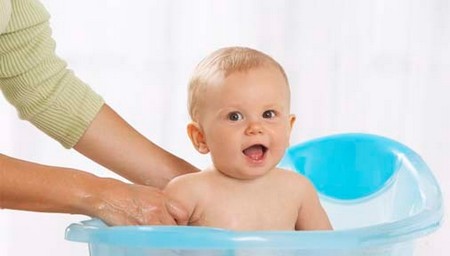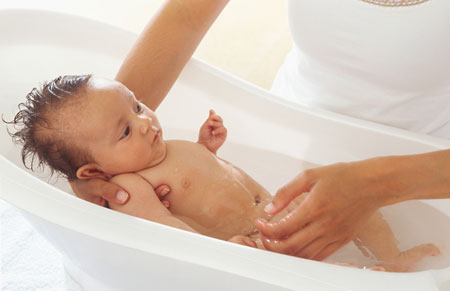You will be shown how to bath your baby by your midwife or health visitor. Pay special attention to washing under his arms, in the folds at the tops of his thighs, behind his knees, round his chin and behind his ears. In other words, wash and dry the skin folds and creases well because a build-up of dirt and sweat can lead to soreness fairly quickly. Your midwife will show you how to look after your baby’s tummy button (umbilicus). If it starts weeping or looks at all sore, remember to tell her when she visits. Dry the tummy button well after washing your baby. Your family soap will probably suit your baby, but some mothers prefer an unperfumed soap and others find that soap dries the skin and so choose a soapless washing liquid. If you use soap, try to avoid getting it in your baby’s eyes and keep his soapy hands away from his eyes too.
It’s a good idea to bath your baby when he’s content. If you bath him when he’s hungry, he’ll probably cry and no one will enjoy it, and if you bath him soon after a feed, he may be sick.
There’s no need to bath your baby every day, but it is a good idea to ‘top and tail’ him – to wash his face and bottom. Dry him carefully, particularly in the folds, using his own towel. Use talcum powder if you like, but take care not to shake it around too much or your baby may breathe it into his lungs. You might like to oil your baby’s skin instead.
There’s nothing wrong with cuddling and washing your baby as you take your own bath, provided that the bath water isn’t too hot for the baby and that there’s another adult with you to pass him to you once you’re safely sitting down in the bath and to take him from you afterwards. Bathing with a baby can be lovely for both parent and child.
Bathing your older child
Older children need just as much supervision in the bathroom as do babies when it comes to checking the water temperature and not leaving them alone. They will gradually learn to wash themselves, but need help for a long time if most of the dirt isn’t to end up on the towel! Wash your daughters bottom gently between the folds of her vulva. Your son’s foreskin may or may not pull back easily. If it does, then gently wash underneath it. If it doesn’t, never try to force it back but simply try again in a few months’ time. It will loosen eventually and no amount of fussing will hurry it up. Teach your child to wash and dry well between his toes. This will help avoid athlete’s foot.

Looking after the skin
If your baby has a dribble rash on his cheeks, chin or neck, protect the skin with petroleum jelly or a silicone barrier cream. This can also help to prevent soreness under the nose when your child has a cold. Encourage children to dry their hands thoroughly to help prevent chapping in cold weather.
Categories
Advertisements
Recent Articles
 How to Understand Bed Sizes – A Small Guide
How to Understand Bed Sizes – A Small Guide How to Select Some Must Have Kitchen Accessories
How to Select Some Must Have Kitchen Accessories Best Way to Change a Car Tire
Best Way to Change a Car Tire Best Way to Write an Affirmation
Best Way to Write an Affirmation Best Way to Take Charge of Your Financial Life
Best Way to Take Charge of Your Financial Life Best Way to Survive a Party When You Don’t Know Anyone
Best Way to Survive a Party When You Don’t Know Anyone Best Way to Stop Self Sabotaging Yourself
Best Way to Stop Self Sabotaging Yourself Best Way to Start Journal Writing
Best Way to Start Journal Writing Best Way to Speak with a Powerful Voice
Best Way to Speak with a Powerful Voice Best Way to Simplify Your Life
Best Way to Simplify Your Life Best Way to Respond to a Put-Down
Best Way to Respond to a Put-Down Best Way to Reduce Acne Breakouts
Best Way to Reduce Acne Breakouts Best Way to Recover from Dining Disasters
Best Way to Recover from Dining Disasters Best Way to Quit Your Job Gracefully
Best Way to Quit Your Job Gracefully Best Way to Make Your Own Website
Best Way to Make Your Own Website


Leave a Reply